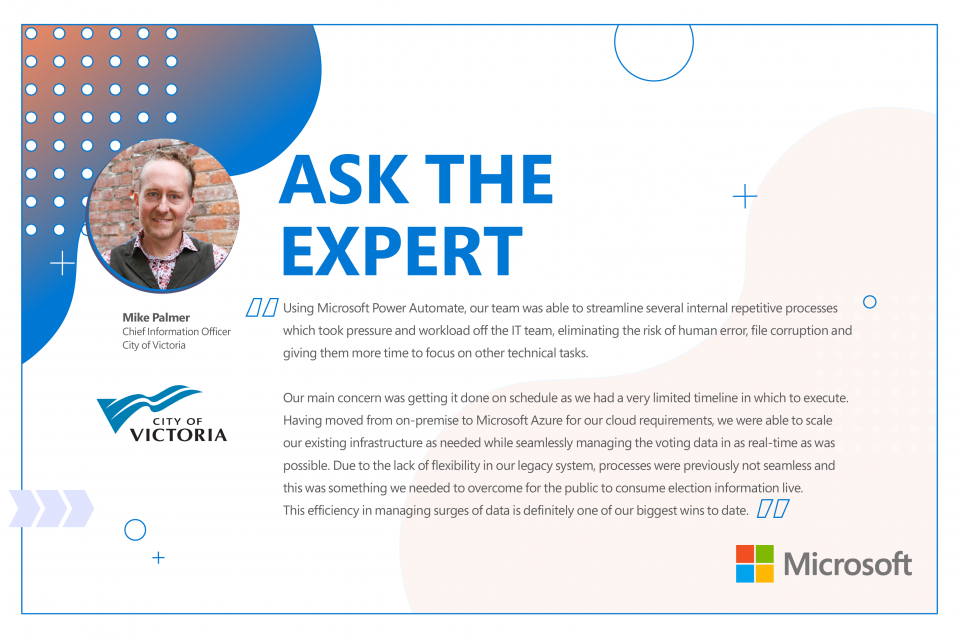By Lisa Carroll, Public Sector Lead, Microsoft Canada
Our “Ask the Expert” series features notable public sector leadership voices to share insights about how their organizations are embracing new technology to improve operations and become future-ready. In this installment, we’re featuring the City of Victoria’s IT team.
It’s not often that we sit back and think about the mechanics and processes that allow us to see election results in real-time on election night. And as we move deeper into a digital era of users who seek instant updates and information accuracy, citizens are also looking for platforms that are easily accessible and user-friendly.
After the previous election run on the legacy system, the City of Victoria’s legislative services department requested that the IT team create a platform that would better serve citizens for the upcoming election. This included an election page that provided live results while being appealing on-screen and user-friendly. This was going to be no easy task as a total over-haul of operations and a tight timeline was ahead. But with an energized and motivated team, along with the support of Microsoft technology and team, they were able to successfully get it done in just a few weeks.
What initially sparked the need to update the election result technology?
The City of Victoria is known for our wide range of digital citizen services the public can access through our website. Services like job applications, bid opportunities, building inspection booking and license applications are available every day at the click of a button.
Every election, our IT team provides election support for the polling stations on election day as well as support the tabulation technology that count the votes. In modern elections there is an expectation from the public to provide live results once the polling stations have closed and votes are being counted but at the time a website providing live results to voters did not exist.
We were asked to build an election results page by our legislative services department and decided to take on this transformation to keep up with the standards of our other digital citizen services. The voting machines have software to tally the votes but this technology doesn’t have the capacity to filter the necessary information to a public website in real time. It was up to us to build the election results page and find a solution that would automate the updating of information on that website as results update over time.
How did this transition impact operations?
Applying this new technology required a complete overhaul of our processes and current system by implementing automation and cloud technology into the workflow. This was necessary to create a responsive platform that would work across mobile and desktop devices, providing the public with accessible, real-time results.
And with the election only a few months away, the team needed this technology to meet a tight timeline. In September 2022, we presented the first prototype to legislative services and by October 12, 2022, three days before the election, the platform had been updated, demoed and was ready to go.
On election night it exceeded our expectations and turned out to be one of the city’s most popular webpages, gaining over 83,000 views.
How did your team use technology like automation and cloud services to solve your most pressing challenges?
Using Microsoft Power Automate, our team was able to streamline several internal repetitive processes which took pressure and workload off the IT team, eliminating the risk of human error, file corruption and giving them more time to focus on other technical tasks.
Our main concern was getting it done on schedule as we had a very limited timeline in which to execute. Having moved from on-premise to Microsoft Azure for our cloud requirements, we were able to scale our existing infrastructure as needed while seamlessly managing the voting data in as real-time as was possible. Due to the lack of flexibility in our legacy system, processes were previously not seamless and this was something we needed to overcome for the public to consume election information live. This efficiency in managing surges of data is definitely one of our biggest wins to date.
For Microsoft, defending democracy by securing critical infrastructure is a core focus. How did the B.C. Votes team manage security considerations with the transformation?
Managing voter data from 13 polling stations across the City is something we take very seriously. It is our responsibility to select partners that can deliver innovation while upkeeping privacy and security requirements that protect citizens. We manage personal information and private data on our servers and protecting that is always top-of-mind for us. The team is thrilled by the multi-layered security provided by Microsoft across physical datacenters, infrastructure, and operations in Azure. It allows us to keep the election results we displayed on our website secure while remaining compliant throughout the process.




